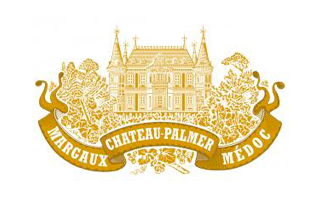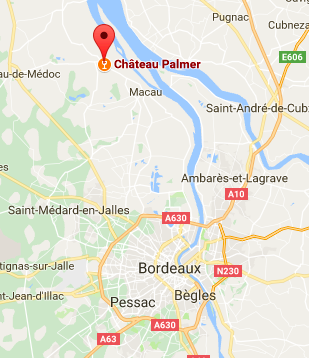 Overview
Overview
Château Palmer is a winery in the Margaux AOC of the Bordeaux region of France. The wine produced here, was classified as one of fourteen Troisièmes Crus (Third Growths) in the historic Bordeaux Wine Official Classification of 1855. The property is situated in the communes Margaux and Cantenac, and its wine is considered to be one of the two most popular Third Growths.
Since 1998, the Château has been producing also a second label, not a second wine, Alter Ego de Palmer, selected from the same quality terroirs, but employing different wine-making techniques and different proportions of grapes. In order to produce an earlier-drinking wine. Some 40% of the estate’s production, is now sold as Alter Ego de Palmer. The result has been a significant reduction in the quantity of wine sold as Château Palmer (from nearly 20,000 cases before the introduction of Alter Ego de Palmer to 11,000-12,000 cases currently). The previous second wine, La Réserve de Général, is not a component of Alter Ego de Palmer, but is now sold off in bulk.
History
 Once a part of the ancient estate, Château d’Issan, divided by the heirs of the Foix-Candale family in 1748, 50 hectares of vineyards came to the Gascq family. Though without association to any noble château, the wine produced became Château de Gascq, quickly established in the market and served at the court of Versailles under Louis XV.
Once a part of the ancient estate, Château d’Issan, divided by the heirs of the Foix-Candale family in 1748, 50 hectares of vineyards came to the Gascq family. Though without association to any noble château, the wine produced became Château de Gascq, quickly established in the market and served at the court of Versailles under Louis XV.
By 1814, the widow of the final Gascq heir, Madame Marie Bumet de Ferrière, sold the property for fr 100,000 to an Englishman, Major General Charles Palmer. Having retired from military life, Palmer invested in the property over the following years, acquiring additional land and facilities. By 1831, the domain extended 163 hectares with 82 hectares under vine, buildings in Issan, Cantenac and Margaux, and had a reputation on a par with Château Margaux and Château Beychevelle. In the early 1840s, Palmer had economic difficulties which would later affect the estate’s position in the 1855 Classification, and was forced to sell the property to madame Françoise-Marie Bergerac in 1843 for fr 410,000, at a substantial loss.
Before World War II, Château Palmer’s owners bought Château Desmirail, another Third Classified Growth, and uniquely in 1963 Palmer wines were sold under the Desmirail name.
Since 2004, Palmer has been managed by Thomas Duroux, formerly a winemaker of Tenuta Dell’Ornellaia.
The Terroir
 Location: Château Palmer’s has a natural logic: a long strip of land set between the Atlantic Ocean and the Gironde estuary. Behind the alluvial land of the palus sits the Brauzes plateau, the first gravelly terrace. This is well-drained land, rich with the deposits of the Garonne and Dordogne rivers, but washed clean of organic matter. Difficult soil for agriculture, but exceptional for grape growing.
Location: Château Palmer’s has a natural logic: a long strip of land set between the Atlantic Ocean and the Gironde estuary. Behind the alluvial land of the palus sits the Brauzes plateau, the first gravelly terrace. This is well-drained land, rich with the deposits of the Garonne and Dordogne rivers, but washed clean of organic matter. Difficult soil for agriculture, but exceptional for grape growing.
Acreage: 55 Ha
Grape Varietals: A grammar composed of equal parts Cabernet Sauvignon and Merlot, topped off with a touch of Petit Verdot. The last is often an exception in the Médoc, but at Château Palmer a rule. Because it is not the variety that determines the quality of the wine, but rather how each variety’s essential characteristics asserts its influence.
47% Cabernet Sauvignon, 47% Merlot, 6% Petit Verdot
Density of the vines: 10.000/Ha
Average age of the vines: The vines have an average age of 38 years and about 1 hectare of land is cleared and replanted each year.
Aging: 18 to 21 months less half of them in new wood.
Biodynamics: Neither a preconceived idea, nor a posture. At first, biodynamics was simply an experiment, sparked by curiosity. The first trials in 2008 proved inconclusive, so meetings were organized with adherents of the method. Slowly, it became evident what truly lies at the heart of biodynamics: a return to the essence of farming. And thus an idea became a conviction – to turn the page on a monoculture, and to recreate a living agricultural organism, in all its diversity. Now, sheep graze, grass grows, flowers and plants with healing properties bloom, and agrochemicals have disappeared. With biodynamics, complexity becomes a source of shared enrichment, where the fruits of human labour benefit people, plants, and all that surrounds. An exquisite equilibrium.

Château Palmer Margaux
Overview: Troisieme Grand Cru Classe in 1855. This is the second most highly rated Margaux wine (based on critic scores): the 2015 vintage was given a score of 96 by The Wine Advocate and the 2015 vintage was given a score of 18/20 by Jancis Robinson. This wine has received more awards than any other wine from the region: the 2011 vintage was awarded Blue-Gold from the Sydney International Wine Competition, and the 2010 vintage was awarded 3 Stars Coup De Coeur from the Guide Hachette des Vins. Among the highest-priced wines from Margaux.
Grape Varieties: Merlot accounts for over 40% of the blend, and as much as 60% in some older vintages, and Petit Verdot is also a relatively significant component, always restricted to 35 hl/ha in order to maximize ripening, and it may account for up to 8% in some recent vintages. The vines have an average age of 38 years and about 1 hectare of land is cleared and replanted each year.
Soil: These stones vary in type, including quartz and quartzite, chalcedony and lyddite, originating from the Quaternary era, much of it arriving in Bordeaux having been swept down from the Pyrenees by the Garonne. They form a fairly deep surface layer, up to four metres deep in places, over a hard bedrock.
Aging: 21 months in oak of which 45% is new

Alter Ego de Palmer
Overview: The Second Wine of Chateau Palmer, Alter Ego was born with the 1998 vintage. It resulted from a new approach to selecting and blending devised to interpret the Château Palmer terroir differently without departing from the values that make the reputation of our wines – namely, finesse and elegance, aromatic richness, harmony and length.
Grape Varieties: Merlot, Cabernet Sauvignon (percentages vary depending on the vintage)
Vinification: At the end of the summer, the slowly maturing berries are regularly tasted to evaluate their potential. The wine makers pay attention to the taste of the grape, the thickness of the skin, and the resistance of the seed. By this time, they already have a sense of what the wines will be like. They are looking for lush grapes for Alter Ego that will release the aromas of fresh fruit. Harvesting and vinification decisions are made based on the idea that they have of the Château Palmer and Alter Ego style. Final blend tastings usually come to confirm their intuitions.
Aging: The batches chosen for Alter Ego are then blended and put into barrels to age for 18 months. The fruitiness and aromatic intensity are preserved by the use of a moderate percentage of new oak barrels (25 to 40%).
Tasting Notes: Offering intense, crispy and juicy fruits, Alter Ego is a spontaneous uninhibited wine, soft and round as soon as it has finished barrel ageing. Its lush aromas and supple tannins make it a wine that can be appreciated in the first years after bottling.


